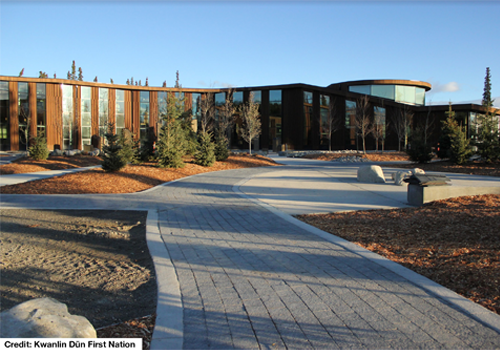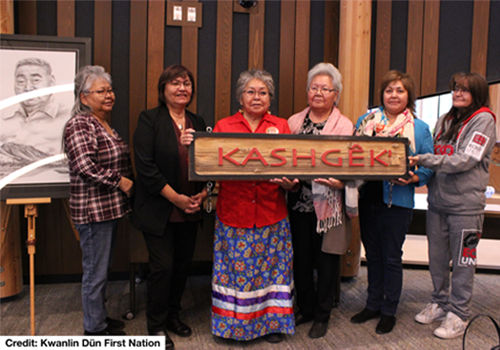Kashgêk’: Connecting Culture, Healing, and Sustainability
Funding provided through the Investing in Canada Infrastructure Program.


In Whitehorse, Yukon, the Kwanlin Dün First Nation’s (KDFN) state-of-the-art Community Hub, the Kashgêk’ building stands as an example of the community's commitment to preserving their culture, fostering healing, and embracing sustainable practices.
'Together Today for our Children Tomorrow' was a 1973 position paper written by Yukon First Nations. It served as the basis for land claim negotiations. Yukon Indigenous leaders went to Ottawa in February 1973, to convince the federal government to begin land claim negotiations.
Having access to an inclusive, culturally-safe space is particularly important to empower and strengthen the identities of First Nation women, girls, Two-Spirit, and gender-diverse people. Officially opened in the Fall of 2022, the building serves as a significant milestone for the KDFN community.
The community hub is named in honour of former Chief Johnnie Smith, who served as the Chief of Kwanlin Dün First Nation for three terms between 1969 and 1988 and played an important role in shaping the future of Yukon's Indigenous communities and the Territory as a whole. Kashgêk’ honours his legacy as part of the historic delegation that presented 'Together Today for our Children Tomorrow' to Prime Minister Pierre Trudeau in 1973.
This presentation laid the groundwork for future land claim negotiations and self-government agreements that have since defined the Territory.
What is Indigenous self-government?
Indigenous governments who make their own choices about how to deliver programs and services to their communities. This can include making decisions about how to better protect their culture and language, educate their students, manage their own lands and develop new business partnerships that create jobs and other benefits for their citizens. Canada recognizes that Indigenous Peoples have an inherent right of self-government guaranteed in section 35 of the Constitution Act, 1982.
A Hub for Healing and Education
The Kashgêk’ building is a sanctuary for the community. The dedicated Elders' lounge serves as a space for gathering, sharing traditional stories, and seeking advice. Additionally, the facility includes spaces reinforcing the community's commitment to healing and growth.
A specialized archival storage area and treatment facilities underscore the importance placed on preserving cultural heritage. The cultural classroom is a hub for language classes and cultural education activities, ensuring the passing on of traditional knowledge and practices to future generations.
Symbolic Design Reflecting Heritage
The Kashgêk’ building goes beyond its functional aspects, incorporating symbolic design elements that align with the Kwanlin Dün First Nation's rich heritage. When viewed from above, the entire structure takes the shape of a leaping fish, symbolizing the community's deep connection to the river. Inside, designs representing the Kwanlin Canyon occur in various elements, from the front reception desk to columns in the outdoor landscaped area. The Council Chambers and outdoor courtyard space follow a circular design, featuring 14 columns representing the unity of the 14 Yukon First Nations. Every inch of the building speaks to the cultural identity and unity of the Kwanlin Dün people.
Sustainable Innovation
Beyond its cultural significance, the Kashgêk’ building also sets a standard for sustainable architecture. The structure is tailored to the northern climate, incorporating renewable energy sources and design features for optimal efficiency. Solar panels, a key component of the building's design, are expected to generate a remarkable 1,512,631 kWh over 25 years, showcasing a commitment to green technology and environmental responsibility. Moreover, the building's orientation maximizes natural light, even during the darkest winter days, creating an energy-efficient and inviting space for the community to thrive.
The Kashgêk’ Community Hub stands as an important physical representation of cultural celebration, healing, and sustainability for the Kwanlin Dün First Nation. Through its thoughtful design and functionalities, it not only paves the way for a resilient future for the community but also exemplifies the unique opportunity to foster vibrant and inclusive communities through investments in social infrastructure in the North. By investing in community spaces and cultural hubs like Kashgêk’, we’re collaborating to create an environment that brings people together, fosters a sense of belonging and contributes to the overall well-being of the community.
Quick facts:
- The Kwanlin Dün First Nation Community Hub was funded through the Community, Culture and Recreation Infrastructure and Rural and Northern Infrastructure streams of the Investing in Canada Infrastructure Program
- Through the Investing in Canada Infrastructure Program, the federal government is investing more than $33 billion in public infrastructure projects across the country. Through the Program, the Government of Canada is helping to build stronger communities, grow our economy and deliver for Canadians.
- Funding for cultural spaces helps responds to Call for Justice 2.3 from the National Inquiry into Missing and Murdered Indigenous Women and Girls. It calls upon all governments to prioritize safe and meaningful access to culture and languages for Indigenous women, girls, Two-Spirit, and gender-diverse people to restore, reclaim and revitalize their identities.
For more information, visit:
Report a problem on this page
- Date modified: